Organic mulches and tree leaves provide a roof over the factory of life – the soil.
An edited version of my article published in ‘Simply Vegetables’ spring 2013, the magazine of the National Vegetable Society
This article combines two of my passions, garden wildlife and composting. The value of mulching around trees, shrubs, hedges, herbaceous plants, etc., is well documented and should be encouraged. It is practised by many gardeners for the benefits it gives to the garden and the plants planted therein. “Compost? Mulch? Oh yes, I mulch around my plants, its good for them”!
I also use it as a top dressing for my raised beds. I never mulch right up to the stems of my plants, leaving a couple of inches free around the plants to discourage any diseases from flourishing and allows the plant stems to breathe. I remove weeds before mulching and compost them for next years mulch!
Benefits of compost mulching for the gardener
| Saves time and effort | Keeps crops clean and dry | Saves earthing up |
| Enriches soil | Improves soil structure | Prevents capping |
| Less watering required | Prevents soil erosion | Aids crops to ripen |
| Suppresses weeds/seeds | Recycles waste materials | Keeps roots cool |
| Retains moisture | Aids crop production | Enhances ornamental beds |
| Raises soil temperature-insulates | Aids pests and disease control | Protects soil, roots, bulbs, crops from frost |
| Absorbs liquid fertilisers and spray drips | Slows soil nutrients leaching | Rich in humus and humic acids |
Different types of mulch
I am not talking about the inorganic materials such as stones, plastic and other man-made woven materials often used as weed suppressants. I’m talking organic mulches here, such as leafmould, leaf litter, straw, wood chips, hay, grass cuttings from chemical-free lawns, shredded newspaper, composted shredded bark, shredded cardboard, manures, worm compost and garden compost. Research is at long last, being undertaken to harness the properties and advantages of organic mulches, which is in effect a blanket of bio-fertiliser over the soil.
Minerals in soils
Many of you know the difference between soil and compost. Fresh compost is in the main, depending upon how you make it and what you add, organic matter and living organisms. Soils contain living organisms, organic matter, humus and rock particles. The rock particles contain the mineral elements, such as iron and phosphate. It is known rocks are broken down into smaller particles by several processes, known as direct weathering. Prime examples are water freezing and cracking the rock, (physical weathering), and rock particles dissolving in acidic rainwater, (chemical weathering). Indirect methods of rock breakdown included biological weathering, whereby in moist environments mosses and lichens slowly break down the rock surfaces and acids released by plants or in leaf litter. Recent research, however, has found another direct weathering of rocks, undertaken by microbes, microbiological weathering! Bacteria and fungi have been found to use a variety of mechanisms to release minerals from rocks.
Benefits to wildlife
There is one huge aspect of organic material mulching that is so valuable, but many people are unaware of these values. That is its value to wildlife. A compost mulch, as are fallen leaves on the soil, is a food resource and home for wildlife, microbes and numerous invertebrates.
Mother Nature’s own compost
Composting is itself a man-made phenomenon. In the wild, you would not find layers of horse manure, tea bags, vegetable peelings, garden waste etc. in one heap. No. But when leaves fall from a tree, onto the soil, this is Mother Nature making her own mulch. It eventually rots down to form leaf mould. Fallen leaves, like mulches, not only help to buffer the soil from extremely cold temperatures, but they also help by offering nooks and crannies for invertebrates to lay eggs, shelter from the cold weather and give them some protection from predators, like birds.
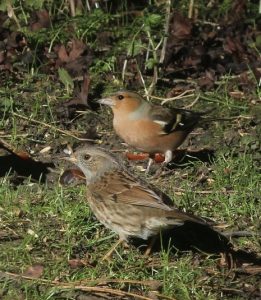
Thicker-billed chaffinch eats mostly seeds. Thinner-billed dunnock eats mostly invertebrates
Dunnocks, for example, have a fine bill designed to pick up small leaves and twigs in search of small seeds or invertebrates and their eggs which they pick up and eat. They, unlike blackbirds, cannot dig deep into the soil itself and grab larger prey items. I wonder what, if any, damage will be done to invertebrates that live in this leafy layer, when people use leaf-blowers? In particular, those used in parks and gardens where the leaves have contact with the soil. Those leaves on concrete paths, roads and highways may not be useful as a mulch over the soil and possibly offer fewer benefits for any invertebrates that may live in it.
A whole new world under our feet!
A whole and surprisingly complex ‘universe of life’ is waiting to be explored directly under your feet and in your compost bin! Microbial activities within the mostly mineral-based soil are perhaps more complex than many other microbiological habitats, especially if plants, trees etc., are growing in it. Microbes, such as bacteria and fungi are absolutely essential to terrestrial ecosystems. Yet they are given very little thought by us or researchers in general. They are the motor for recycling nutrients and elements from plant material (such as carbon, phosphorus, sulphur and nitrogen). Some bacteria even recycle gases from the air! A prime example is the bacteria that take nitrogen from the air and deposit it via nodules on your runner beans roots.
“Hot spots”
Plant root surfaces and rhizospheres (areas immediately around actively growing plant roots) are known as ‘hot spots’ of activity for microbes, particularly fast-growing bacteria and fungi which have been called ‘fast flora’. There is a whole ecosystem around your plant roots! Moving up the roots, nearer the shoot, i.e. the older region of the plant, root hairs and root cells may be sloughed off where the grazers, e.g. protozoa and nematodes feed. Further away from the hot spots, >4 mm, slower-growing bacteria, fungi, organic matter fragments and some mycorrhizal fungi hyphae are found. A hidden jungle world of predators and prey all live in soil and mulches.
How can this benefit plants, birds and other wildlife?
The microbial activity within soils and compost heaps have similarities and some unique characteristics. Laying an organic mulch on top of soil marries the two systems to some extent, which in turn can benefit the larger wildlife, such as birds. In and around plant roots the area is teeming with microbes. Earthworms are attracted to such ‘hot spots’. Many people are aware that earthworms live in compost heaps and soil. People believe that they are eating organic matter. In reality, earthworms shred and swallow organic matter because they themselves derive their nutrition from the microbes which themselves are consuming and decomposing the waste material! In other words, earthworms are predators of microbes! Their vermicompost contains many more microbes than they consumed! They are then deposited into the soil with the vermicompost. All of this and much more can be read in my book “Composting with Worms. Why waste your waste?”
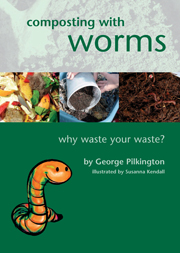
Read about vermicompost benefits and much more!
Hedgehogs will find more food in a compost mulch than on your lawn
Hedgehogs and birds will hunt for earthworms, beetles and other tasty invertebrates in compost mulched areas and ‘hot spots’ of microbial activity. For example, I have seen blackbirds pull out newly planted onion sets from the soil, to seek out and eat invertebrates and earthworms that themselves were feeding on the soil microbes and detritus underneath the sets and amongst the roots. Compost heaps per se would certainly not have such ‘hot spots’ with them not containing living root systems. But garden compost, laid on top of the soil around a plant would encourage and promote root growth, and therefore ‘hot spots’! The mulch will be colonised by many forms of wildlife who use it for dispersal, shelter, egg-laying, breeding or foraging. In fact, many invertebrates will complete their whole life cycle in it, a whole universe of biodiversity right under your feet in your very own garden!
Mulch and fallen tree leaves as a protector
Mulching protects the soil structure from heavy rains and frosts, as do tree leaves. It can help prevent the soil from freezing to a greater depth than would otherwise have occurred. It helps to maintain a more even and stable soil temperature. Stability in an environment enables and encourages biodiversity within the mulched area and hence your garden. Heavy rains can easily wash away the finer soil particles and small weed seeds from the surface. The mulch supplies a constant food supply for the numerous small invertebrates underneath it and offers them egg-laying or nesting areas protects and shelters them from the weather and predators.
Benefits of a friable soil
As the mulch decays (i.e. consumed by the microbes) worms pull the mulch into the soil which in turn assists in making the soil loose and friable, allowing birds to hunt easily in it as opposed to having to chisel their way through a hard crust of surface soil or frozen soil. A more friable soil allows invertebrates etc., to burrow deeper in situ as opposed to moving out of the area altogether, like a cellar in your house! They can stay put instead of exposing themselves to predators and the elements. The friable soil allows ever precious air to find its way into the soil helped by worms as they create tunnels through it, these tunnels offer hiding places for invertebrates. The looser the soil, the more invertebrates can find places to live and eat. The more invertebrates, the more predators. Soil life determines the structure and porosity of your soil. Just look at your allotment soil as opposed to hard clay which most soil life find difficult to live in.
Friable soils will encourage and promotes root growth and hence earthworms! Mulches can also assist in preventing some weed seeds from germinating leaving them in the uppermost soil layers to be found by birds that feed on small seeds, such as dunnocks, as they search through the loose mulch material. They want to find seeds, not young growing weeds! Soil organisms thrive under a mulch, improving soil biodiversity and eventually assisting in the release of useful plant nutrients. As mentioned above, mulches retain moisture which allows more small creatures to live in it. Dunnocks, in particular, enjoy eating enchytraeids, (pot worms), which need a moist environment to live. They need a watery film within the soil which has to be kept in direct contact with their body to stop them from drying out and aids their mobility. They are known as ‘saprovores’, meaning they feed upon dead and decaying organic matter, just like the larger earthworms, which they resemble except they are much smaller and whitish. They love mulches and can be plentiful there. Mulches provide food, shelter, moisture and darkness, all of which they need. They are also preyed upon by many ground living beetles and their larvae, predatory mites, nematodes, fly larvae and centipedes.
What’s for lunch?
What tasty titbits can birds and other wildlife find amongst a mulch? Besides numerous organisms again with their predators, which we nor birds can see with the naked eye, there are enchytraeids, earthworms, mites, springtails, numerous fly species and their larvae,(fruit flies in abundance), thrips, fungus gnats and their larvae, earwigs, caterpillars, beetles and their larvae, grubs, spiders, centipedes, leather jackets, ants, woodlice, millipedes slugs, snails and many other bugs and invertebrates. I have watched on many occasions blackbirds finding small slugs amongst the mulch. They have to continually wipe their beaks on the nearby grass lawns to deal with the defensive slime before eating it. You may get lucky and find a pseudoscorpion!
A song thrush using an anvil to crack open a snail- a natural form of pest control!
Calcium sources
Calcium, like other elements, can be leached from the soil by rain and particularly acid rain. Where do they find the large amounts required for egg production? Grit, eggshells, calcium-rich sand, lime-rich mortar and possibly the bones of dead small mammals and bones found in owl pellets. But who has such calcium-rich sources in their gardens? Some bird food retailers add oyster shell grit to their bird foods to assist birds, at breeding time. There are records of song thrush or blackbird eggshells, and small snail shells found in blue tits nests. Birds are also known to eat their own shells when the young have hatched. Waste not, want not!
Snails, compost and song thrushes
Song thrushes are a snail specialist. Their behaviour is unique amongst bird species. In fact, when the ground is dry or frozen and earthworms, a key resource for them, are scarce, snails prove to be a lifesaver for our shy song thrushes. Hence they have evolved to predate upon them and have learnt how to smash open the shells. Song thrushes will diligently search through composted mulch patches in search of snails. The larger, more aggressive blackbirds are more catholic in their food choices and can find alternative food resources when the ground is dry. Unlike song thrushes, they cannot make use of snails as a food resource. Although they do bully song thrushes who waste time and energy searching and cracking open the shells only for the blackbird to steal the snail when all the work is done! This is known as kleptoparasitism! Ordinarily, birds do not eat living snails because of the hardness of their shells. They eat the empty snail shell. Snails will lay their eggs in the compost, whether it is in the garden compost bin or in the composted mulched borders. Snails try to avoid being eaten by making their shells stronger or more ornate. They hide until the shells are hard. This needs calcium, gleaned from the vegetation growing in soils with a calcium content and time for the young snail to grow. Young snails hatch as soon as the weather warms up and as they have a very thin shell it is very easily crushed hence are targeted hedgehogs. These young snails need moisture and food, protection from predators and the drying effects of the sun, all amply supplied amongst compost mulches and compost bins.
Slug pellets
To protect their beautiful flowers bought from the garden centre, many people use slug pellets. Besides the toxicity of slug pellets, killing snails with poisons reducing their numbers can only deplete snail shell availability in our gardens, at this critical time for our birds. Snail shells are considered to be the main source of dietary calcium for them and song thrushes depend upon snails themselves through the dry summer and are an absolute bonus in the frozen winter months. They are steeply in decline and are red-listed as a bird of serious conservation concern. Something to ponder upon!
Snail shells, a useful calcium source for garden birds
Who may come for an invertebrate lunch?
What wildlife have I seen taking advantage of this feast found in my mulching? Pied and grey wagtails on my mulched and open vegetable beds, which are next to my pond with the following birds foraging and eating invertebrates within my borders with trees, shrubs and plants; robins, blackbirds, redwings, mistle thrushes, fieldfares, jays, magpies, wood pigeons, collared doves, chaffinches, dunnocks, very occasionally blue tits, coal tits and great tits, with starlings and house sparrows on the fringes of the borders, greenfinches and goldfinches looking for seeds and even the wren ventures down onto the mulch scurrying here and there picking off some tasty morsels with song thrushes eating snails. I have seen birds carry away mulched materials to make their nests with. I’ve observed the sparrow hawk as it walks in amongst the bordered shrubs to flush out birds or corner them next to the wooden fencing panels as they were busying themselves in the areas. Hedgehogs, wood mice, frogs, toads and newts have all been seen hunting in or feeding amongst my mulched borders.
But the bird that most satisfied me and gave the most pleasure was the chiffchaff in late December early January 2008. It stayed in and around my garden for a least 4 days. It was feeding upon and inside the flowers of a mahonia ‘charity’. What fascinated me though was it keep flitting and even hovering for very short periods, darting from one shrub to another close by. I saw it catch numerous small gnats as they danced their little dance a couple of feet above the mulch. The mulch was a mixture of garden compost, worm compost and leafmould all mixed together about 3 inches deep and was being used by the possibility to feed or rest.
Using garden compost or worm compost from your food waste is an excellent way to recycle nutrients into the soil. Mulching around your valuable plants is an investment well worth the small effort in undertaking this worthwhile task. Besides investment in your plants, treat it as an investment in wildlife too, much of which you will, not yourself see! But be satisfied in the knowledge that many other creatures will! I would say that there would probably be more small invertebrates within your mulched areas than your lawns making it far more attractive to our garden wildlife with whom we share our gardens and allotments!
Download the benefits of mulching to wildlife and birds
Refs. Besides my own experiences and observations:
Jeffery. S et al (2010) “ European Atlas of Soil Biodiversity”, European Commission, Luxembourg
Perrins. C (1979), “British Tits” The New Naturalist, Collins, London
Pilkington. G (2006)” Composting with worms. Why waste your Waste?” Ecologic Books, Bath.
Toms. M, (2009) “Going for a song. Song thrushes” Bird Table 59, Summer 2009, British Trust for Ornithology
Photo of song thrush with thanks from Roy & Marie http://www.moorhen.me.uk/index.htm

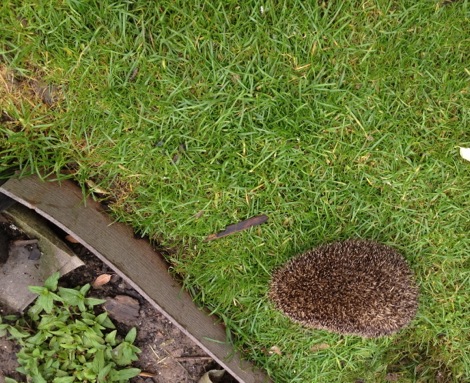
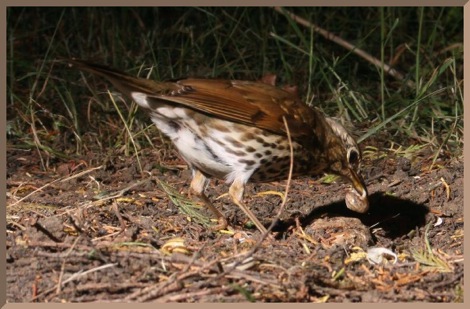
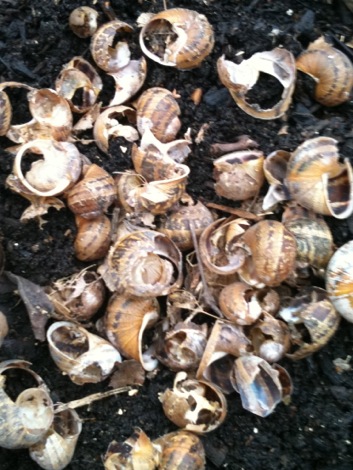
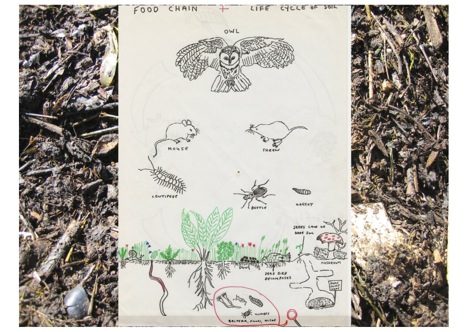
very interesting article and one we can all learn from, thanks
Thanks Roger, such a valuable resource made from waste whereby everything benefits, a real case of a win-win situation!
Hi George,
I really enjoyed reading this article. We have a really big compost section in our garden and i regularly take out the slugs for our resident robin to feed on . He seems to know exactly when that lid comes off the composter ……….
As for the calcium…after reading your article if I find any empty snail shells I shall cruch them and put them on the bird table ……..I cannot think of a better way for those horrid smails to be recycled !!
Charlotte
Thanks Charlotte, you only need put them on the table prior to breeding, although blackbirds nest for a long period and may have several broods….so do keep putting the crushed shells out. Cheers George
Love your article, and I never thought to crush up snail shells! I often find them around the garden after the Song Thrush has been.
I crush egg shells and sprinkle around my plants to protect from slugs, it never occurred to me that birds would use these and snail shells for calcium. I will be amending my gardening routine to incorporate this.
Many thanks
Thanks. Seems to make sense re recycling snail shells eh?!!